A Paper and A Self
The Vanderbilt Austral: A Paper and a Self for Nashville’s University
This is not the Vanderbilt you know today. But you might see your reflection in its yellowed pages; you might hear your voice in a certain turn of phrase from its founding students. They pull one way, eyes fixed on Cambridge and New Haven, but the institution leans inwards into its mission to resurrect a war-torn South from the weight of deficiency. Situated in that crossroads between North and South, establishment and emerging, stands a student body intent on carving out a distinct sense of identity for themselves and what will always be their alma mater. They cannot be the ones left behind while change marches past. And it moves quickly.
All they have are their words. Here you will read the words of students longing for an audience. This is not a history, it is a newspaper. This is the Vanderbilt Austral.
Buoyant Beginnings
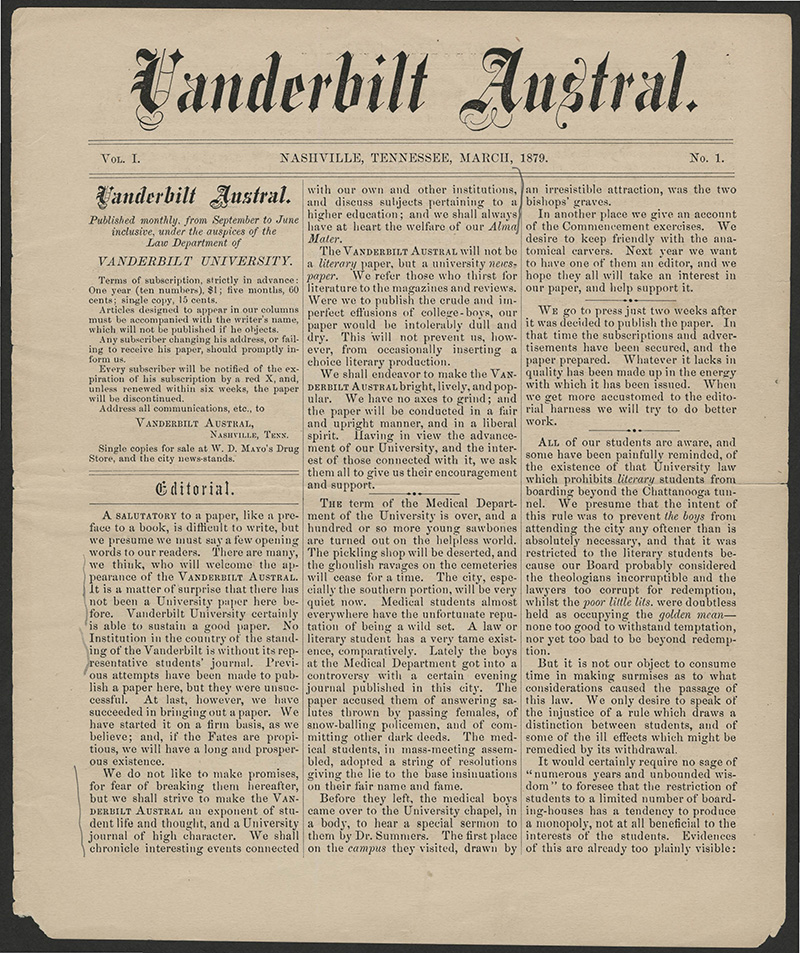
The Vanderbilt University Law Department
The Vanderbilt Austral Vol. I, No. 1 (March 1879)
Newspaper
Nashville, Tennessee
Vanderbilt University Special Collections
It was finally done. Here you see the first student publication of Vanderbilt University, published in March of 1879, only six years after the university’s founding.
Led by an anonymous group of students against faculty who dismissed their efforts as childish and presumptuous, the newspaper ultimately published only four monthly issues before being shuttered. In an election that May, one unnamed officer indiscreetly reported the identities of the new editorial board on a bulletin board, exposing the entire operation. Prior to re-enrolling in the fall, student stockholders of the unauthorized company financing the Austral were required to pledge to cease publication and dissolve the corporation.
As italicized in the middle column, the Austral’s editors carefully distinguish themselves from other student literature-focused papers. Instead, they declare from the beginning a pride in what is as rebellious, and simple, as a human-centered university newspaper named for the South.
The Competition
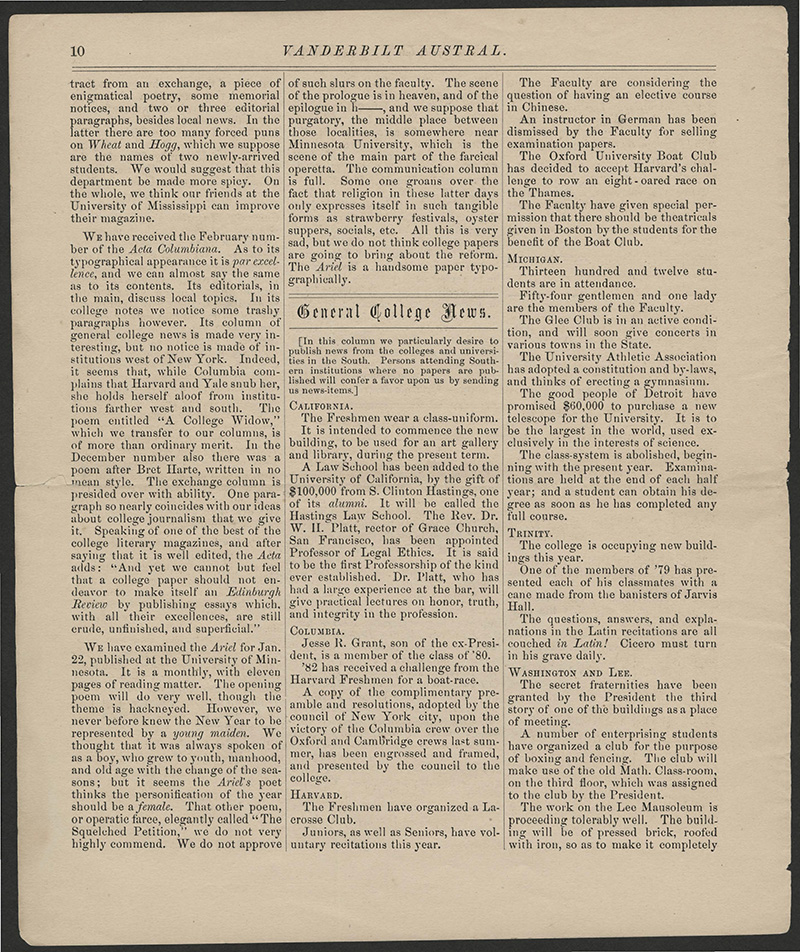
The Vanderbilt University Law Department
The Vanderbilt Austral Vol. I, No. 1 (March 1879)
Newspaper
Nashville, Tennessee
Vanderbilt University Special Collections
What is a newspaper without reference to its competition? Here you see an “Exchanges” section in the left and middle columns with reviews of various college newspapers, including Columbia University’s Acta Columbiana. In contrast to an earlier separation from lofty literary papers, The Austral’s editors take a strong stance in pointing out “some trashy paragraphs” in the Acta Columbiana. The editors also highlight a geographic bias in the Acta Columbiana’s omission of news from any institution west of New York, memorably noting that “while Columbia complains that Harvard and Yale snub her, she holds herself aloof from institutions farther west and south.” For a first issue, The Austral boldly leaps to tackle the biggest names, then and now, in higher education.
But what do the faults identified in the Acta Columbiana reveal about these students’ own priorities? The answer may lie in their own selection of news coverage below.
A Benchmark Behind the Rest
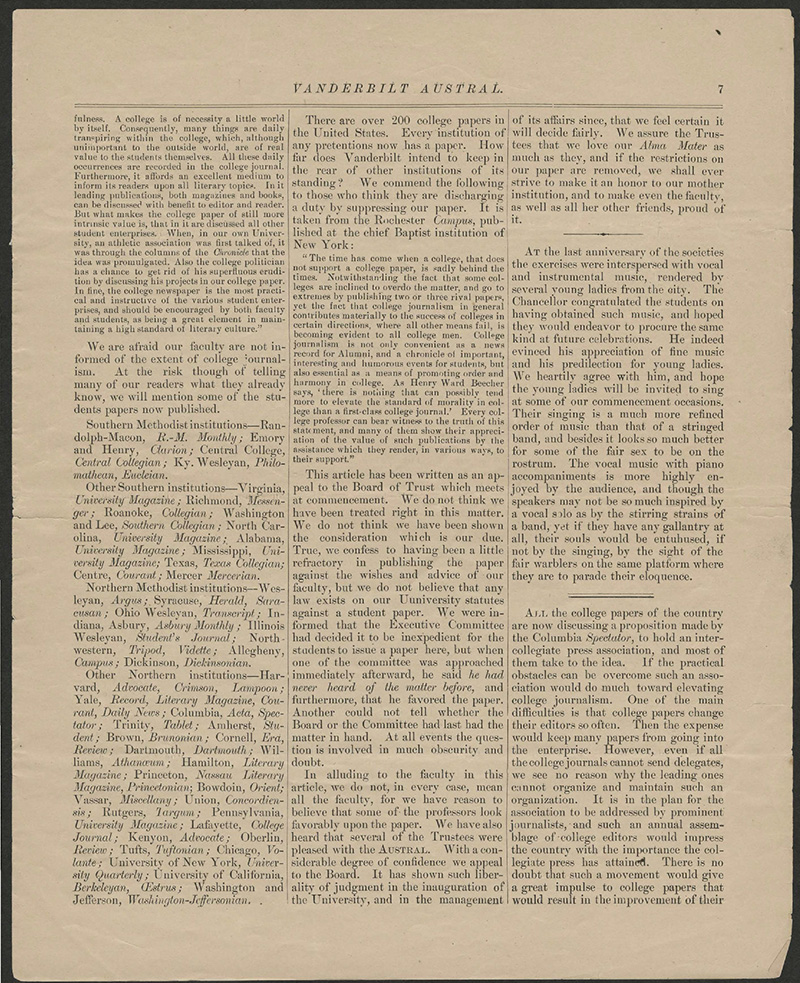
The Vanderbilt University Law Department
The Vanderbilt Austral Vol. I, No. 3 (May 1879)
Newspaper
Nashville, Tennessee
Vanderbilt University Special Collections
The intensity of The Austral editors’ petition to the Board of Trust can hardly be contained within the paper’s margins. Alternating between densely printed quotes from contemporaries insisting that a college without a newspaper “is sadly behind the times,” an italicized list of peer institutions, and their own argument in normal typeface, this is a visually striking plea to support student journalism.
The dominating presence of northern newspapers reflects the lingering effects of the Civil War on the finances of the southern education system. With a boyish student body unprepared for the rigors of college, Vanderbilt was unwilling to devote its resources to anything beyond establishing a basic standard of education for its undergraduates. As faculty claimed, “there was not ability enough here…to run a paper.”
But students insisted on their potential. As they beg, “We simply propose to give the students an organ of which they need not be ashamed.”
Imagine a Gymnasium
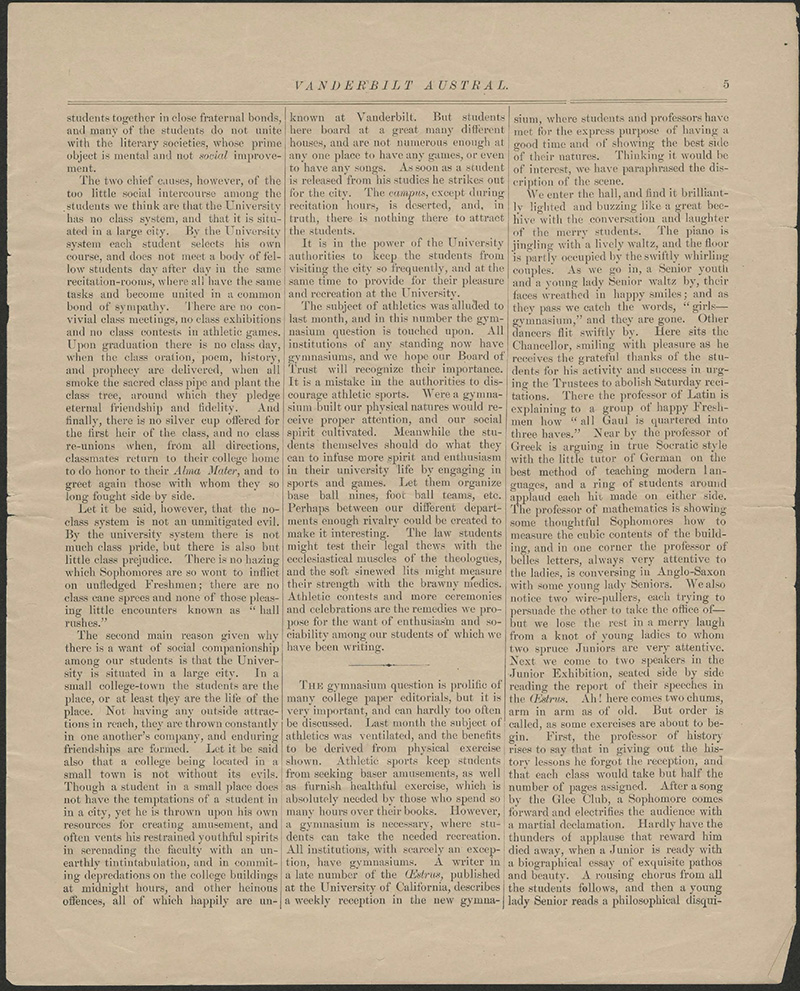
The Vanderbilt University Law Department
The Vanderbilt Austral Vol. I, No. 3 (May 1879)
Newspaper
Nashville, Tennessee
Vanderbilt University Special Collections
There are two parts to this page: a need and a want. Here The Austral’s writers publish a critical editorial on the lack of community within the student body. They recommend that Vanderbilt “keep students from visiting the city so frequently,” instead providing for “their pleasure and recreation at the University.” The students demand a proof of commitment, and they believe that they deserve as much as a reason to feel connected to their campus.
How The Austral editors imagine building such community? They want a gymnasium. It is a remarkably simple request—and reveals much about how the students perceive the authenticity of their own collegiate experience at the moment.
But there’s also a deeper meaning to the wish. The rightmost column muses on a reception at the University of California’s new gymnasium in Berkeley, a picturesque scene most memorably invoking the easy relationships between professors, students, and each other.
What’s in a Name
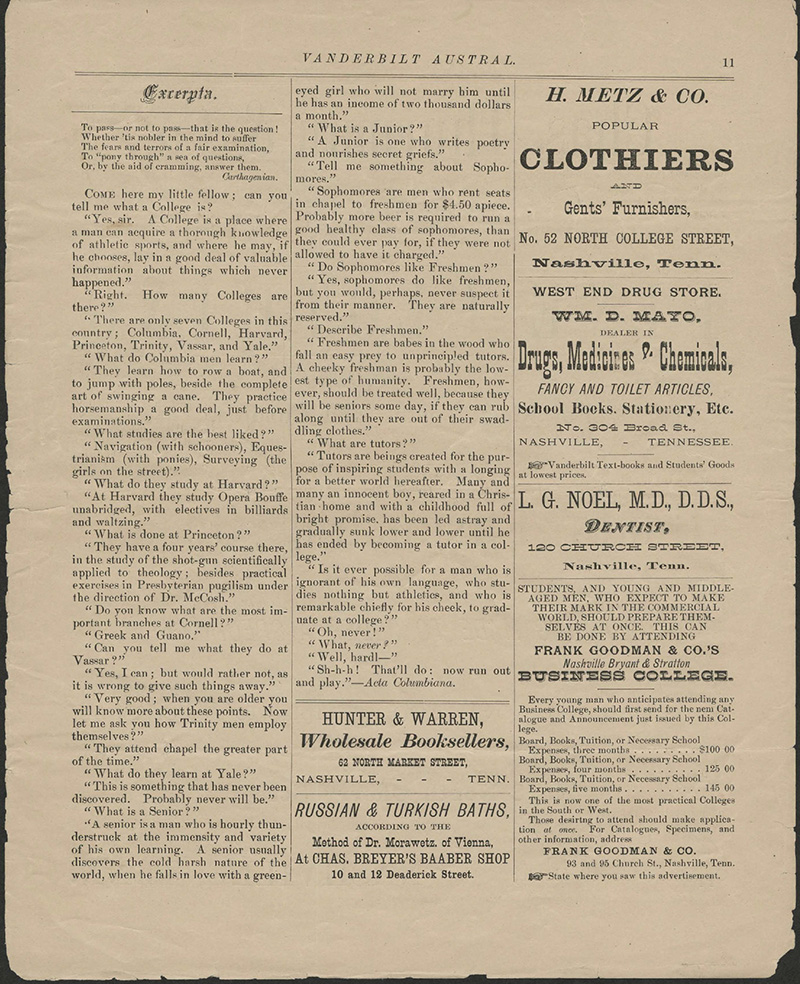
The Vanderbilt University Law Department
The Vanderbilt Austral Vol. I, No. 3 (May 1879)
Newspaper
Nashville, Tennessee
Vanderbilt University Special Collections
What is left unsaid by The Austral’s editors is as powerful as what is written. Here is a section of “Excerpts” featuring works published by other college newspapers.
The dialogue dominating the left and middle columns is reprinted from the Acta Columbiana of Columbia University, and depicts a tongue-in-cheek conversation between a child and an older individual mocking several prominent New England institutions, the collegiate class system, and more. While satiric, the excerpt successfully pinpoints the period’s more superfluous aspects of college life; from there being “only seven Colleges in this country…with electives in billiards and waltzing” to freshmen being “babes in the wood who fall an easy prey,” it is a wholly idealistic representation of higher education.
But in considering the advertisements to the right, Vanderbilt students are not entirely excluded. Practical considerations of buying medicine and books, while perhaps uncollegiate, are at least part of the real world.
The Honor of a Mention
Hannah Tsiao
The Honor of a Mention (2021)
ArcGIS Map
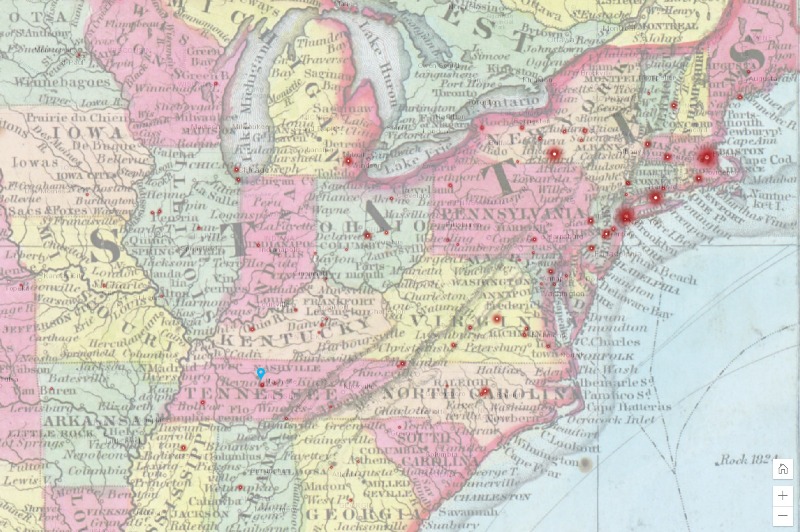
Base map source: United States Census Office. 9Th Census, 1. & Walker, F. A. (1874) Statistical atlas of the United States based on the results of the ninth censuswith contributions from many eminent men of science and several departments of the government. [New York J. Bien, lith] [Map] Retrieved from the Library of Congress, https://www.loc.gov/item/05019329/.
This map displays the name, location, and frequency of mention of all institutions of higher education included in The Austral; 97 different schools were referenced in just four issues, and the size of each data point correlates to its frequency of mention. The notes section of select data points contain particularly memorable comments from Austral writers regarding certain institutions, and the citation section features each institution’s issues of appearance.
The Austral from its very first issue aimed to serve as a platform for southern college news. Whether it accomplished that goal is up to interpretation of the map. Yet for an underground student newspaper, The Austral‘s editors achieved something elusive: to be unexpectedly, defiantly, known. Vanderbilt University is highlighted on the map as a reference point, but ultimately it is just that—one point among many. In the end, The Austral was a part of something larger than itself.
https://vanderbilt.box.com/s/s1j8ttaxg2ephvu8vyqk81mjw3p8ve9m
